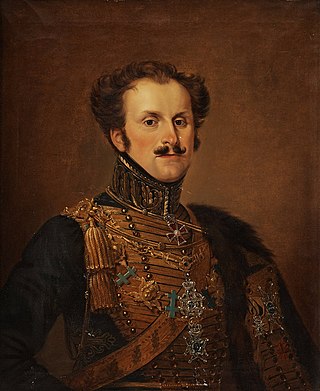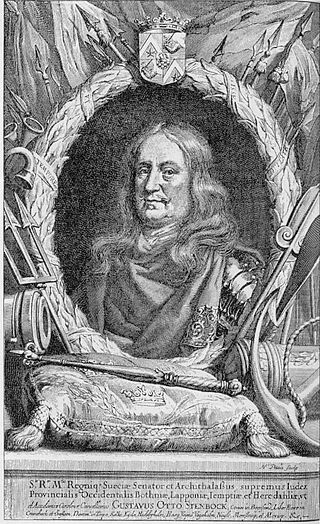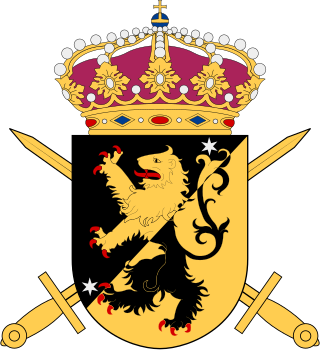This is a list of Swedish military commanders. Several Swedish monarchs also acted directly as military commanders.
Contents
| Part of a series on |
| Lists of Swedes |
|---|
 |
| List of Swedish people |
This is a list of Swedish military commanders. Several Swedish monarchs also acted directly as military commanders.
| Part of a series on |
| Lists of Swedes |
|---|
 |
| List of Swedish people |

Nils Magnus Brahe was a Swedish statesman and military officer during the War of the Sixth Coalition. He served as the Marshal of the Realm between 1831–1844 and was known as the influential favourite of Charles XIV John, King of Sweden.

Count Gustaf Mauritz Armfelt was a Finnish-Swedish-Russian courtier and diplomat. In Finland, he is considered one of the greatest Finnish statesmen. His advice to Russia's Tsar Alexander I was of utmost importance for securing the autonomy of the Grand Duchy of Finland.

Gustaf Otto Gustafsson Stenbock was a Swedish military officer and politician.

The Swedish nobility has historically been a legally and/or socially privileged class in Sweden, and part of the so-called frälse. The archaic term for nobility, frälse, also included the clergy, a classification defined by tax exemptions and representation in the diet. Today the nobility does not maintain its former legal privileges although family names, titles and coats of arms are still protected. The Swedish nobility consists of both "introduced" and "unintroduced" nobility, where the latter has not been formally "introduced" at the House of Nobility (Riddarhuset). The House of Nobility still maintains a fee for male members over the age of 18 for upkeep on pertinent buildings in Stockholm.
The Governor of Stockholm was the head of the Office of the Governor of Stockholm, and as such he was the highest Swedish State official overseeing the affairs in the City of Stockholm between 1634 and 1967. The Governor was the equivalent in Stockholm of a county governor elsewhere in Sweden.

The Governor of a province of Finland headed the activities of the State Provincial Office until the end of 2009, when the provinces were abolished. The governors were appointed by the President. Many former ministers including but not limited to Kaarlo Hillilä, Martti Miettunen, Hannele Pokka and Anneli Taina served as governors, since the post was regarded as prestigious enough for a retiring minister, but still politically neutral. The title of maaherra was also considered a personal title, such that once appointed, the title maaherra remained for life.

Ebba Magnusdotter Brahe was a Swedish countess, landowner, and courtier. She is foremost known for being the love object of King Gustavus Adolphus of Sweden, and because he wished to marry her prior to his marriage, plans which were however never realized. Their love affair has been famous in the Swedish romantic history and the subject of fiction, and are documented in their preserved correspondence.
Lantmarskalk, was the title of one of the speakers of the Swedish Riksdag of the Estates, from 1627 to 1866 and of the Diet of Grand Duchy of Finland from 1809 to 1906. The Lantmarskalk was appointed by the Estate of the Nobles and also served as its speaker (talman). The Lantmarskalk should not be confused with the Riksmarsk or the Riksmarskalk, which were Great Officers of the Realm and royal appointees.
The Nyland and Tavastehus County Cavalry Regiment was a Swedish Army cavalry regiment located in the county of Nyland and Tavastehus that traced its origins back to the 17th Century. It was split in 1791.

The Skaraborg Regiment, designation I 9, was a Swedish Army infantry regiment that traced its origins back to the 16th century. It was converted to an armoured regiment in 1942. The regiment's soldiers were recruited from Skaraborg County, and it was later garrisoned there.
The Lord High Constable was a prominent and influential office in Sweden, from the 13th century until 1676, excluding periods when the office was out of use. The office holder was a member of the Swedish Privy Council and, from 1630 and on, the head of the Swedish Council of War. From 1634, the Lord High Constable was one of five Great Officers of the Realm.

The Lord of the Realm was a title of honour introduced by Gustavus III, King of Sweden shortly after his coup and the newly passed constitution. The title was granted by the King and was first received by Frederick William, Prince von Hessenstein on 15 January 1773 by letter. One of the most famous title holders was Hans Axel, Count von Fersen, the supposed lover and confidant of Marie Antoinette, Queen of France.
Historiens 100 viktigaste svenskar is a book by Niklas Ekdal and Petter Karlsson, published in 2009. Before the book was released, the list was published by Dagens Nyheter between 14 April and 6 May. The book is a list of the 100 Swedes that according to the authors have had "the greatest influence on Swedish people's lives, and also people's lives around the world". There are 84 men and 16 women on the list. Around 40 of them lived in the previous century, and 16 were still alive as of the book's publication.

Events from the year 1790 in Sweden

The Gustavians were a political faction in the Kingdom of Sweden who supported the absolutist regime of King Gustav III of Sweden, and sought after his assassination in 1792 to uphold his legacy and protect the interests of his descendants of the House of Holstein-Gottorp.
Brahe is the name of two closely related Scanian noble families.